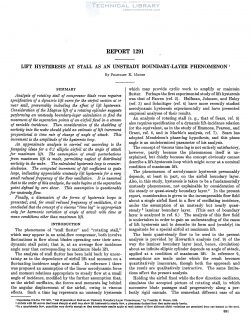naca-report-1291
- Version
- 117 Downloads
- 1,004.52 KB File Size
- 1 File Count
- November 2, 2016 Create Date
- November 2, 2016 Last Updated
National Advisory Committee for Aeronautics, Report - Lift Hysteresis at Stall as an Unsteady Boundary Layer Phenomenon

SUMMARY
Analysis of rotating stall of compressor blade rows requires
specification of a dynamic lift curve for the airfoil section at or
near stall, presumably including the effect of lift hysteresis.
Consideration of the Adagnus lift of a rotating cylinder suggests
performing an unsteady boundary—layer calculation to find the
movement of the separation points of an airfoil fixed in a stream
of variable incidence. Then consideration of the shedding of
vorticity into the wake should yield an estimate of lift increment
proportional to time rate of change of angle of attack. This
increment is the amplitude of the hysteresis loop.
An approximate analysis is carried out according to the
foregoing ideas for a 6:1 elliptic airfoil at the angle of attack
for maximum lift. The assumption of small perturbations
from maximum lift is made, permitting neglect of distributed
vorticity in the wake. The calculated hysteresis loop is counter-
clockwise. The computed increment of lift coeficient is quite
large, indicating appreciable unsteady lift hysteresis for a very
small reduced frequency of the flow oscillation. It is assumed
that to the order of this analysis, the wake begins at the separation
point defined by zero shear. This assumption is questionable
for unsteady flow.
Finally, a discussion of the forms of hysteresis loops is
presented; and, for small reduced frequency of oscillation, it is
concluded that the concept of a viscous “time lag” is appropriate
only for harmonic variation of angle of attack with time at
mean conditions other than maximum lift.
INTRODUCTION
The phenomena of “stall flutter” and “rotating stall,”
which may appear in an axial-flow compressor, both involve
fluctuations in flow about blades operating near their aero-
dynamic stall point; that is, at an average flow incidence
angle near that corresponding to maximum blade lift.
The analysis of stall flutter has been held back by uncer-
tainty as to the dependence of airfoil lift and moment on a
fluctuating incidence angle near stall. In reference 1 there
was proposed an assumption of the linear aerodynamic force
and moment relations appropriate to steady flow at a small
angle of incidence, modified by the further assumption that,
as the airfoil oscillates, the forces and moments lag behind
the angular displacement of the airfoil, owing to viscous
effects. Such a time lag represents an unsteady hysteresis
which may provide cyclic work to amplify or maintain
flutter. Perhaps the first experimental study of lift hysteresis
was that of Farren (ref. 2). Halfman, Johnson, and Haley
(ref. 3) and Schnittger (ref. 4) have more recently studied
aerodynamic hysteresis experimentally and have presented
empirical analyses of their results.
| File | Action |
|---|---|
| naca-report-1291 Lift Hysteresis at Stall as an Unsteady Boundary Layer Phenomenon.pdf | Download |

Comment On This Post